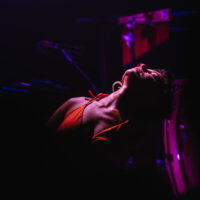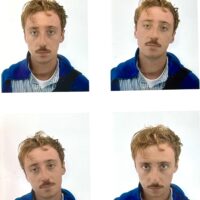Biographie
Depuis qu’il est sorti de l’école Joaquim Fossi joue dans des films de Emmanuel Poulain-Arnaud (Le Test, 2021), Yvan Attal (Les Choses Humaines, 2021), Jean Luc Herbulot (Jour de Colère, 2023) et au théâtre avec Guillaume Vincent (Vertige), Christophe Rauck (Richard II) et Macha Makeieff (Dom Juan). Il fabrique en parallèle ses propres objets de théâtre. En 2021, il présente à la Maison Folie Moulins (Lille) un récit de voyage et d’échec dans Hôtel Terminus. En 2023, il créée La Carte du Tendre, une installation immersive qui interroge le public sur ses perceptions spatio-temporelles dans le cadre de La Nuit des Musées avec le Théâtre Nanterre-Amandiers. Cette année, Il construit sa structure, Club Tendre, aimablement épaulé par l’Amicale de Production.
Since graduating from school, Joaquim Fossi has acted in films by Emmanuel Poulain-Arnaud (The Test, 2021), Yvan Attal (The Human Factor, 2021), Jean Luc Herbulot (Day of Wrath, 2023), and in theater productions with Guillaume Vincent (Vertigo), Christophe Rauck (Richard II), and Macha Makeieff (Don Juan). In parallel, he creates his own theatrical pieces. In 2021, he presented a story of travel and failure in Hôtel Terminus at Maison Folie Moulins (Lille). In 2023, he created The Map of Tenderness, an immersive installation that questions the audience’s spatial and temporal perceptions, as part of La Nuit des Musées with the Théâtre Nanterre-Amandiers. This year, he is building his own structure, Club Tendre, with the kind support of the Amicale de Production.
Résidence — 46 fois le Louvre
Since last January, we have visited the Louvre about twenty times with Noham to draw and write. From these visits, we have created a book in which Noham describes the artworks, and I draw them. We worked with the fragility of our practices, with our areas of ignorance, with the joy of being there, and with our evolving perspective.
A feeling developed gradually throughout this process: a sense of fear in the face of the fragility of these objects, and by extension, the fear of the collapse of our civilization and what will remain after us.
This is where my desire to create a theatrical, living form of this book came from—to transform these objects into an oral story, to recount these masterpieces without showing them, as if we were in a museum of the museum, in the future, after its destruction.
![Programmes de résidence Kinski-RuiPaxao[o°]CollectifDesFlousFurieux-5](/wp-content/uploads/2023/03/kinski-ruipaxaoocollectifdesflousfurieux-5-200x200.jpg)



